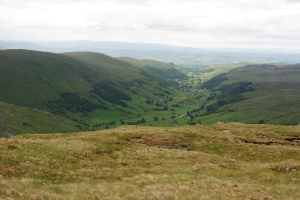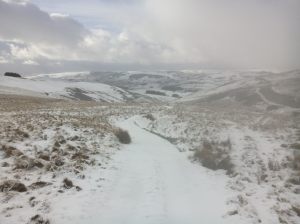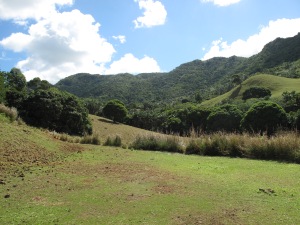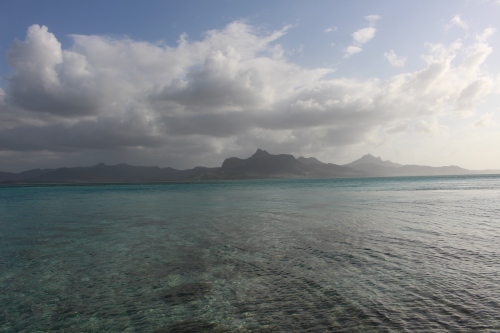I approached the distinctive summit cairn of Thornthwaite Crag in thick cloud, happy to find a distinctive point on the otherwise gently sloping summit ridge that links High Street to several other Lakeland peaks. Huddled behind the wall were several walkers, kitted out in waterproofs and hats, with large bags. ‘You’re brave to be wearing shorts,’ one shouted at me above the wind. I looked down, I was indeed wearing running shorts and a long sleeved shirt, not clothes to hang around in. I ran off down a path after smiling at the group and waving. Thinking about it afterwards, I should have said ‘actually this is the driest September on record, so I wanted to make the most of it.’ But you never think about it at the time.
At this point I was half-way through my time on day 1 of the Rab Mountain Marathon, a two-day score event based somewhere two hours from Manchester. This year, in the far eastern Lake District, there was a healthy mix of mountain crags, boggy uplands, and thick unrunnable heather to make any route choice a challenge. The map was the same for both days, but on each day different controls were ‘active’, and you only found out which these were as you began. Then you have a set time – either 7 or 6 hours on day 1, and then 6 or 5 hours on day 2, depending on whether you were doing the long or short course.
The greatest challenge for me is trying not to get carried away at the start and run off without planning at least the first section of a reasonable route – not only which controls I thought I could get to and in what order, but whether I could get to the finish in time, and what I could afford to cut out in the event of either overestimating my ability, or getting horribly lost. Luckily there was what seemed an obvious objective – at the top, furthest away section of the map, were two of the controls with the highest available points, relatively close together. Linking the start to these controls, and then from there to the overnight camp, I linked up a bunch of other controls that sort of marked out a route. An unlikely sightseeing itinerary.
Running up the first stretch, along a boggy stream and then higher up, following the line of rushes and finally under some crags and up a steep slope to the wide summit of a boggy ridge heading north west, I was finally alone in the cloud. This area is the Shap Fells, and is infrequently visited in comparison to the rest of the Lakes. I saw no one until I dropped down to a track and headed down to the Haweswater Reservoir, past a large group of school children and a few other walkers. The reservoir soon appeared, brooding grey with Kidsy Pike behind. I followed a wall and began a gruelling ascent to the summit of Mardale Ill Bell. This was the remoteness you can get from a mountain marathon, taking part in an event with hundreds of others, knowing there will be people to chat to that evening and swap stories with, yet able to run and climb alone for much of the day.

An hour or so later, descending out of the cloud into another valley, the distant sun finally broke through and Windermere appeared in the distance. With a gentle slope, spongy underfoot I practically flew down the four kilometres to the next control and then, in striking contrast, began the steepest ascent of the day. Using hands to grip the grass and staring at the ground, up I went, with two hours until my time was over and two mountain ridges to run over and down, it was a hard push.
I began to see other people as I crested this ridge and followed the path along, and then suddenly there were more than ten runners, all looking for the same spot as I was. It felt like a crowd, like getting into the London underground. There were people more regularly now, heading off in a bizarre combination of compass bearings to find those last one or two controls and associated points before they had to make the final dash for the finish. I was tired by this point, and my legs were uncooperative, but I put my head down and jogged ferociously for the finish, joining a path over the last hill and dropping down into Longsleddale and the campsite.
Dumping a backpack on the ground and stretching always feels good after a race, but after 7 hours of running it feels transcendent. Feeling different muscles I also had that little niggling thought that I still had 6 hours of running the next day. But that was more than 12 hours away, and with plenty of time for food and sleep in-between, I put it out of mind. Slowly the campsite began to fill, and those of us there got to watch the constant flow of runners down the steep hillside up the valley, where a steep final checkpoint had been placed to lure people in. Pairs of runners cooked together, and solos like me made friends. Paul and Stewart, who I had come up with, found me amongst the maze of green tents. Paul had a grim time running in circles, lost for an hour and a half trying to find one control in the mist, eventually moving on when it became too frustrating. Stewart had done some incredible ascents and was in first place at the end of day 1. I looked at his route and realised that I was nowhere near that level. We ate and the sun gave us a final show, lighting up the crags under a near blue sky.
The best approach to day 2, as far as I can determine, is to spend the first hour realising how tired you are, and how much your legs are refusing to move properly, and then to pretend you don’t want to give up. I moved slowly, heading up onto moorland north of Kendal where a lot of controls were placed and moving doggedly between them, conscious of the time but trying to keep an even pace. The ground was not running terrain – hard gnarly heather clumps and peat hags moved ankles in unfriendly ways. I was seeing more people than on day 1, and the controls were laid out in a way to suggest routes – not that this made the day any easier. It was a dry day but there wasn’t much sun, merely high flat cloud hanging over the Eden Valley and the distant Pennines.
After this stretch of moorland the only option was to head down into Longsleddale again and then up a tortuous zigzag path onto the next ridge. This had to be crossed, along with the ridge after, before the finish, and there were a few controls on each that I felt I had time to run to, though it was very tempting to make a beeline for the finish tent and the hot meal that was waiting. I tried to enjoy the view and found it strangely uplifting – cloud still hung on the high fells to our north and sparks of sunlight fell on the moor. Woodlands crowded the slopes and at one point I was picking my way through one to the promised path, admiring the moss covered boulders and smooth dead wooden branches poking up from the earth.
The final slope, which went up to one control, along a low ridge to another, and then down to the finish, was a procession of people, runners who had all chosen to finish this way. No doubt on some other hill there was another procession finishing via a different option. Navigation is no longer an issue – you follow the march of hobbling, deep breathing men and women, all starting to lose their confident focus. I looked at my watch, mindful of the Dutch father and son I had spoken to the night before who, in the previous year had tried to get one particular control, took far longer than expected, ended up more than half an hour late and got zero points for their efforts. I knew I could finish, but I also wanted to lie down and go to sleep. Every patch of boggy grass looked like an excellent bed. The finish, and associated tents and banners, shot into view less than a kilometre away and a few hundred metres beneath us from the final control. Like a wounded pack of barbarians attacking a well defended Roman fort we stumbled and flung ourselves down the hill, some people clearly running out of time. The last few hundred metres downhill on tarmac were not pleasant. But it was over, and of course it was brilliant.
There are of course times during a two-day event where you question why you are there. Luckily these are outweighed by all the usual things people enjoy – the sense of adventure, the camaraderie, the stunning landscapes, the excitement of finding a control and realising that you can in fact navigate. But more than this, an event like this pushes your body and your mind into places most people never experience, at the height of what you are capable of, not only in endurance but in mental control. I love walking, passing through a landscape and exploring it, but sometimes you need to go beyond this, to get off the path and put yourself into a state where you not only pass through a landscape but embrace it, where you decide to run uphill into the worsening weather because more than finding controls and getting to the finish, you get to experience the mountain and your own limits together, and remember that the mountains are always bigger than you are. It is about looking past the fact that most of the hills are essentially sheep pastures, and that walls and fences and paths are frequently encountered and are used to navigate. It is about experiencing the things we will never tame, the slippery wet rock, the disorienting mist, the fierce wind, the majesty of the sun shining through the cloud onto the watery pools in the marsh, the vision of a single person running through a grand landscape, surrounded by mountains.




